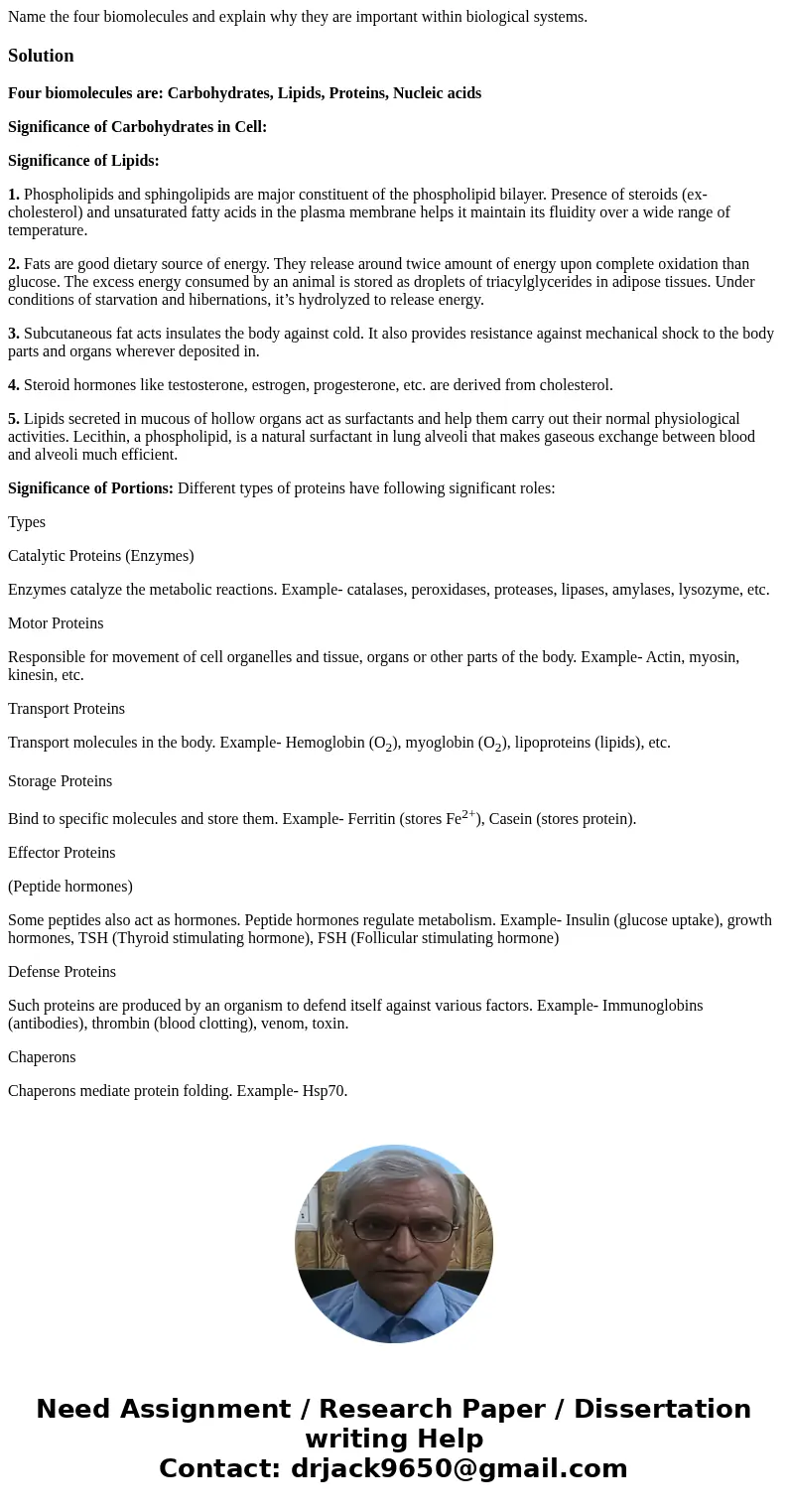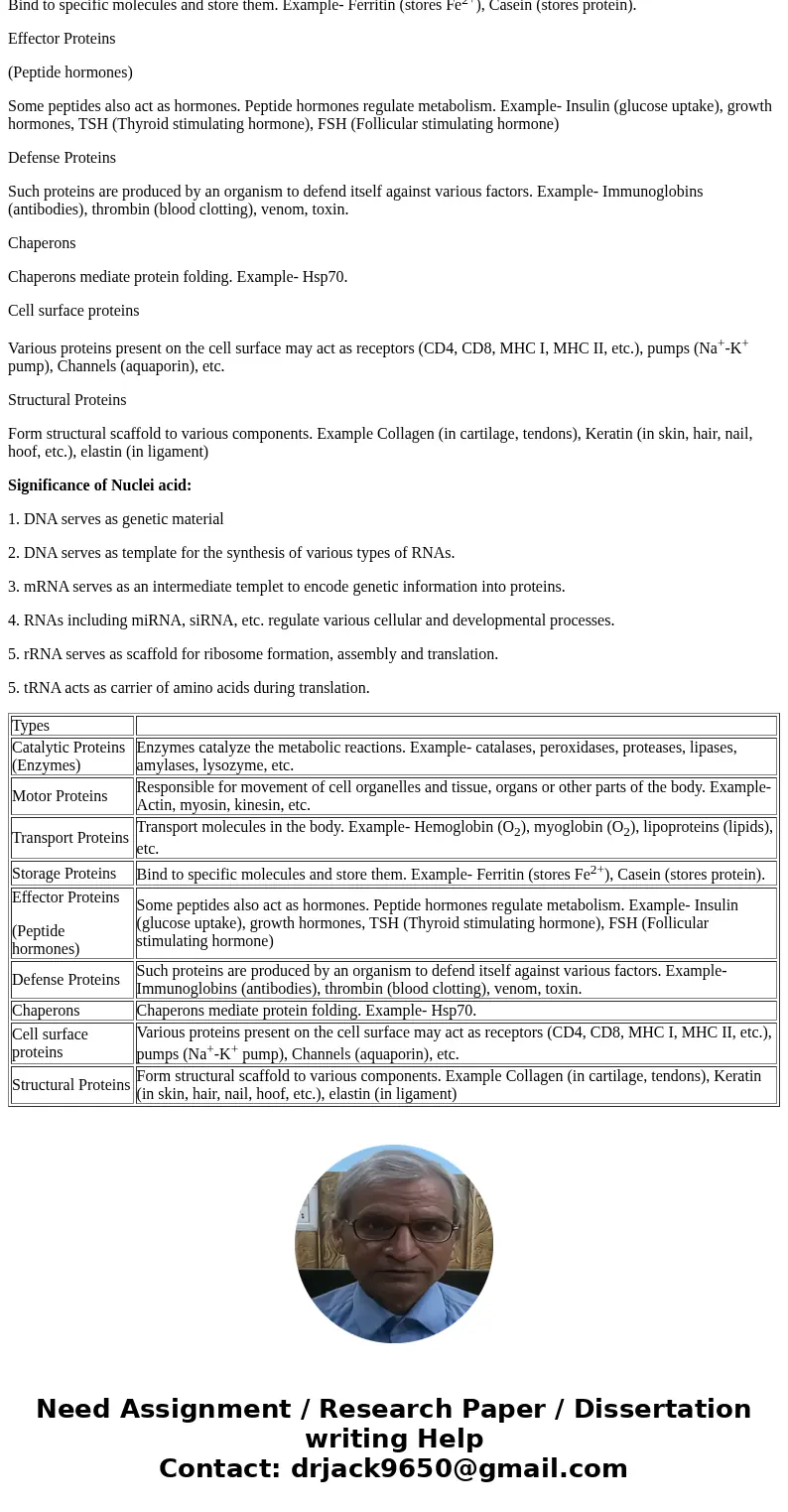Name the four biomolecules and explain why they are importan
Name the four biomolecules and explain why they are important within biological systems.
Solution
Four biomolecules are: Carbohydrates, Lipids, Proteins, Nucleic acids
Significance of Carbohydrates in Cell:
Significance of Lipids:
1. Phospholipids and sphingolipids are major constituent of the phospholipid bilayer. Presence of steroids (ex- cholesterol) and unsaturated fatty acids in the plasma membrane helps it maintain its fluidity over a wide range of temperature.
2. Fats are good dietary source of energy. They release around twice amount of energy upon complete oxidation than glucose. The excess energy consumed by an animal is stored as droplets of triacylglycerides in adipose tissues. Under conditions of starvation and hibernations, it’s hydrolyzed to release energy.
3. Subcutaneous fat acts insulates the body against cold. It also provides resistance against mechanical shock to the body parts and organs wherever deposited in.
4. Steroid hormones like testosterone, estrogen, progesterone, etc. are derived from cholesterol.
5. Lipids secreted in mucous of hollow organs act as surfactants and help them carry out their normal physiological activities. Lecithin, a phospholipid, is a natural surfactant in lung alveoli that makes gaseous exchange between blood and alveoli much efficient.
Significance of Portions: Different types of proteins have following significant roles:
Types
Catalytic Proteins (Enzymes)
Enzymes catalyze the metabolic reactions. Example- catalases, peroxidases, proteases, lipases, amylases, lysozyme, etc.
Motor Proteins
Responsible for movement of cell organelles and tissue, organs or other parts of the body. Example- Actin, myosin, kinesin, etc.
Transport Proteins
Transport molecules in the body. Example- Hemoglobin (O2), myoglobin (O2), lipoproteins (lipids), etc.
Storage Proteins
Bind to specific molecules and store them. Example- Ferritin (stores Fe2+), Casein (stores protein).
Effector Proteins
(Peptide hormones)
Some peptides also act as hormones. Peptide hormones regulate metabolism. Example- Insulin (glucose uptake), growth hormones, TSH (Thyroid stimulating hormone), FSH (Follicular stimulating hormone)
Defense Proteins
Such proteins are produced by an organism to defend itself against various factors. Example- Immunoglobins (antibodies), thrombin (blood clotting), venom, toxin.
Chaperons
Chaperons mediate protein folding. Example- Hsp70.
Cell surface proteins
Various proteins present on the cell surface may act as receptors (CD4, CD8, MHC I, MHC II, etc.), pumps (Na+-K+ pump), Channels (aquaporin), etc.
Structural Proteins
Form structural scaffold to various components. Example Collagen (in cartilage, tendons), Keratin (in skin, hair, nail, hoof, etc.), elastin (in ligament)
Significance of Nuclei acid:
1. DNA serves as genetic material
2. DNA serves as template for the synthesis of various types of RNAs.
3. mRNA serves as an intermediate templet to encode genetic information into proteins.
4. RNAs including miRNA, siRNA, etc. regulate various cellular and developmental processes.
5. rRNA serves as scaffold for ribosome formation, assembly and translation.
5. tRNA acts as carrier of amino acids during translation.
| Types | |
| Catalytic Proteins (Enzymes) | Enzymes catalyze the metabolic reactions. Example- catalases, peroxidases, proteases, lipases, amylases, lysozyme, etc. |
| Motor Proteins | Responsible for movement of cell organelles and tissue, organs or other parts of the body. Example- Actin, myosin, kinesin, etc. |
| Transport Proteins | Transport molecules in the body. Example- Hemoglobin (O2), myoglobin (O2), lipoproteins (lipids), etc. |
| Storage Proteins | Bind to specific molecules and store them. Example- Ferritin (stores Fe2+), Casein (stores protein). |
| Effector Proteins (Peptide hormones) | Some peptides also act as hormones. Peptide hormones regulate metabolism. Example- Insulin (glucose uptake), growth hormones, TSH (Thyroid stimulating hormone), FSH (Follicular stimulating hormone) |
| Defense Proteins | Such proteins are produced by an organism to defend itself against various factors. Example- Immunoglobins (antibodies), thrombin (blood clotting), venom, toxin. |
| Chaperons | Chaperons mediate protein folding. Example- Hsp70. |
| Cell surface proteins | Various proteins present on the cell surface may act as receptors (CD4, CD8, MHC I, MHC II, etc.), pumps (Na+-K+ pump), Channels (aquaporin), etc. |
| Structural Proteins | Form structural scaffold to various components. Example Collagen (in cartilage, tendons), Keratin (in skin, hair, nail, hoof, etc.), elastin (in ligament) |


 Homework Sourse
Homework Sourse